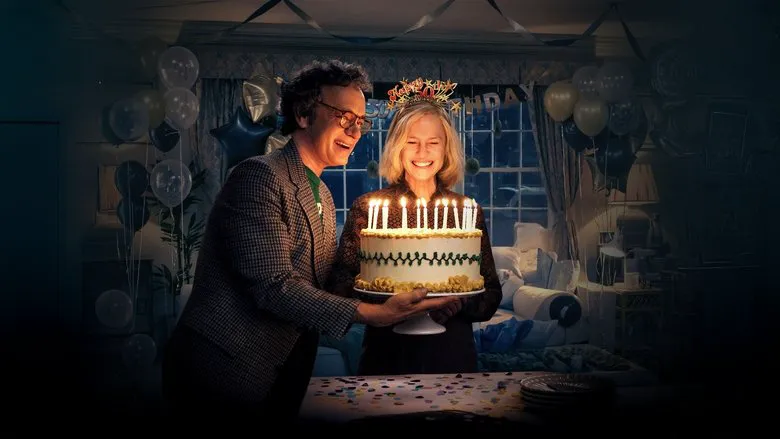“Here”: A Unique Cinematic Experiment
The American drama “Here,” recently released, stands out as a truly unique film. Its distinction lies not just in the heavily publicized reunion of the “Forrest Gump” team, but in its innovative presentation, with director Robert Zemeckis once again venturing into filmmaking as a technological experiment.
Zemeckis’s Two-Fold Experimentation
Zemeckis’s experiment is essentially two-part. Firstly, he reunites Tom Hanks and Robin Wright as a couple, but primarily showcases AI-restored, younger versions of them. However, this aspect has drawn criticism from many viewers because, constrained by current technology, the AI-generated faces can still appear somewhat unnatural on the big screen.
Secondly, the movie is almost entirely constructed of static shots, fixed camera angles, and unchanging scenes. All narratives unfold within the confines of a house’s living room, silently and at a distance witnessing a century’s worth of events. We observe an empty plot being transformed into a new house, the first owners moving in with excitement, and then generations of inhabitants coming and leaving. This essentially transforms the audience into observers stationed in this one spot, experiencing all the joys and sorrows, and the relentless march of time.
Technical Prowess Over Story
The film’s novelty lies in its deliberate weakening of the content, placing almost complete reliance on the director’s and the post-production team’s technical capabilities. The actors are secondary, the characters lack significant depth, and even the plot takes a backseat. Even if viewers struggle to differentiate character relationships or recall anyone’s name, they can still grasp the intended feeling – the quiet passage of years, and the constant flux of the world.
Interesting Form and Disrupted Time
However, this unconventional form is compelling in its own right. The unvarying structure of the house allows extensive creative freedom in editing, fostering image collages, innovative transition designs, and the interweaving of stories from different periods. One moment we might see inventors from over a century ago celebrating and enjoying life, and in the next moment scene will cut to a modern couple arguing. The scene might change from a father teaching his child words, and suddenly jump again to the old father who is feeble and aged. Life mirrors a play while plays frequently resemble reality. Time slips away faster than we expect.
This non-linear narrative condenses the emotions, with happiness or sorrow able to switch abruptly in a single cut. Although this creates a strong contrast, a side effect is the fragmented narrative of each set of residents. This leads to plot confusion, creating a sense of disorientation in many viewers.
The Central Family Storyline
Nevertheless, the most complete storyline revolves around the main couple and their family. The parents initially spend their savings to buy the house, where they witness their son grow up, fall in love, and start his own family, before ultimately passing the house on to him. In pursuit of making their lifestyles align with this house’s grandeur, the son chooses the path of giving up dreams for art. But as he becomes an iconoclast, the idealistic lover of his wife vanishes. She desires escaping the house and rediscovering their shared past, which creates disagreements inevitably leading to divorce.
The House as a Symbol of Time
In film and television, houses can symbolize residents’ inner spaces; diverse rooms’ styles reflect the characters within. But the house in “Here” has a significance far surpassing it. It is like an anchor, for while time runs continuously there is it stands. The camera maintains within the house facing a wide window, so the streets outside appear in different versions for each era. Also similar to one window, the film captures different glimpses that highlight life into a series containing segmented clips.
The Moving Shot and Broad Perspective
The single instance where one part of time gets put in front by all film components, marking as where everything from inside switches far from what exterior appears and displays landscapes too where another collection that stands seems fairly familiar. Most scenes happen like in film, but each moment we notice in many circumstances happens at least inside day-present timelines and so aspects overall give each moment this enormous value when telling just their overall feelings as moments become as if they happened historically.
This technique harks back memories of “In the Mood for Love’s” final cut within news from start as film takes only one topic with many private moments or male views then before switching from camera the events happened instead during this frame allowing feelings become extracted when enlarged from all viewpoints to allow a feel to dust down through time as how even individual feeling will seem almost no substance in such a lengthy overview.
Conclusion: A Unique and Thought-Provoking
“Here”, a standout film with both strengths along what aspects people believe are weak which weaves different paths through fragments of numerous stories by using various cuts that tell from one to multiple life’s aspects while offering the comfort you will seek regarding anxiety by just having peaceful flows that help. In the film’s conclusion where you witness at first how she wanted from anything just get so far, we find her at the point the scenes give reasons toward just moments throughout. As how her memories dissolve where no anger rests, as how what began gets felt finally when at where end to conclude film when you recognize “HERE” makes most connections from love’s moments whether those are there next like feelings that exist while helping feel satisfied during these many times through.